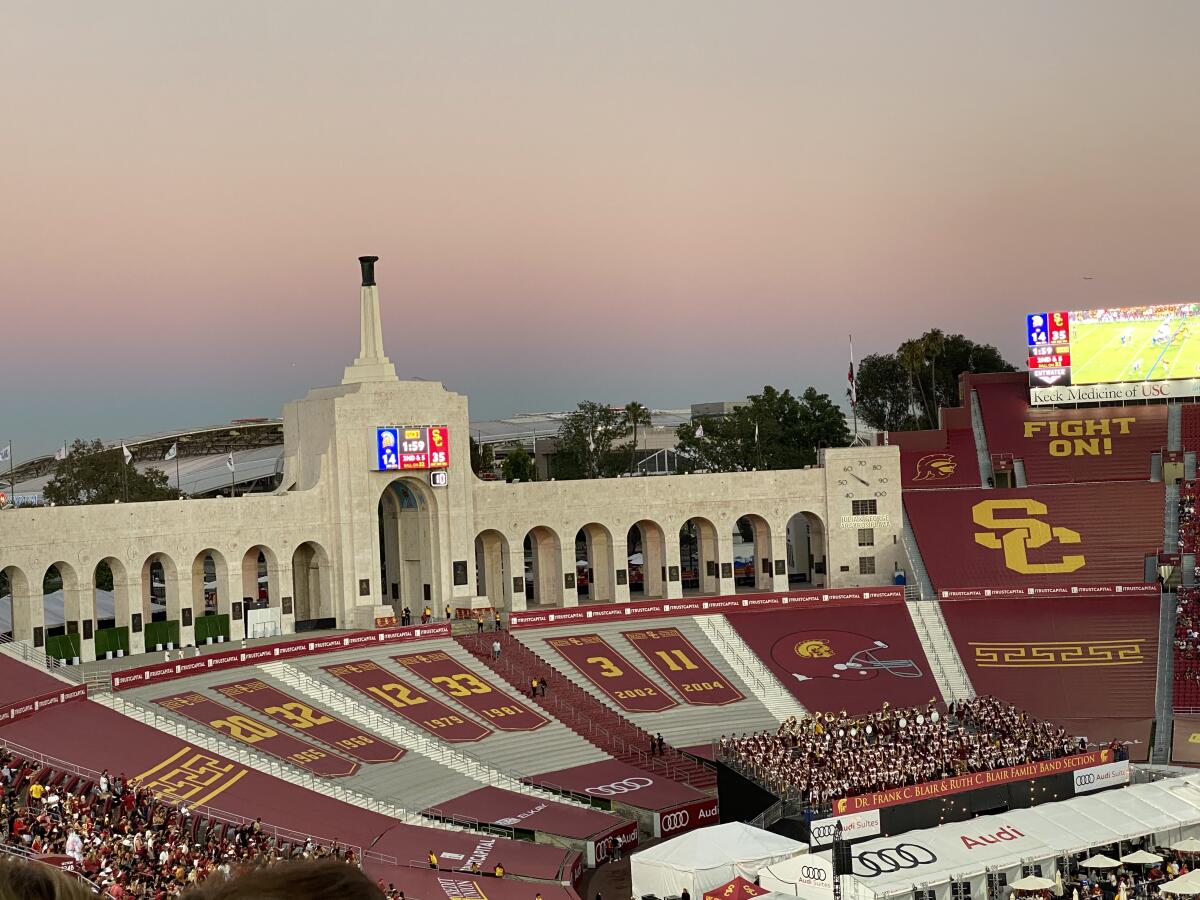Restoring California wetlands and fighting climate change? Leave it to beavers

- Share via
Good morning. It’s Wednesday, Sept. 13. Here’s what you need to know to start your day.
- Beavers bounce back, bringing big benefits
- Morocco earthquake is a warning for California
- And here’s today’s e-newspaper
Sign up for Essential California
The most important California stories and recommendations in your inbox every morning.
You may occasionally receive promotional content from the Los Angeles Times.
Restoring California wetlands and fighting climate change? Leave it to beavers
A baby beaver was spotted scurrying near a creek in Palo Alto, marking the first sighting of the species in that area in decades — and possibly signaling a beaver colony’s return to the region after more than a century. Pretty dam exciting.
“After being hunted and harassed for hundreds of years, the North American beaver is poised to make a comeback in the Golden State,” my colleague Grace Toohey reported.
That comeback is welcome news for California ecologists, including Kate Lundquist and Brock Dolman, co-directors of the nonprofit Occidental Arts and Ecology Center’s Water Institute. Beavers are “the great wetland creators and managers,” Lundquist said. Their survival instinct also serves to combat drought.
“They’re just this big rodent that’s trying to avoid getting eaten,” she said. Beavers build their famous dams so they can avoid predators by using underwater entrances to their homes. Those dams help recharge groundwater.
Beavers’ projects also support a variety of plant and other animal species that thrive in the wetland environment their dams create. They can also foster healthier conditions for struggling fish populations, Dolman said. Plus, the corridors they help sustain have been shown to do better against wildfires.
“Where beaver habitat is on the landscape is disproportionately small … but it’s disproportionately important and beneficial,” he said. “To not work with these species to our collective benefit seems like we’re just missing a whole lot of opportunities.”
As state agencies look to restore threatened wetlands and reduce the risk of devastating wildfires, they’ve enlisted beavers’ help. The California Department of Fish and Wildlife launched a beaver restoration program this summer, implementing new policies aimed at protecting beavers from water managers and landowners that view their construction projects as a nuisance.
“This new policy formally recognizes beavers as a keystone species and ecosystem engineers in California,” department Director Charlton H. Bonham said in a news release, calling the rodents “the Swiss army knife of native species.”
Some view beavers as a nuisance, but Lundquist told me that the tension really comes down to the fact that humans spent decades killing beavers and draining their native habitats. Now as beavers make a comeback, they’re reclaiming that habitat for themselves, she said.
If the animals are chomping down trees or causing flooding where they shouldn’t, Lundquist and Dolman noted there are several techniques that can be used to safely keep beavers in check or relocate them.
Both said the effort toward coexistence is key to embracing natural infrastructure’s potential to restore habitats and address the effects of climate change. That’s a major shift from the “modern settler-colonist-industrial mind-set” that Dolman said has proved to be “ecologically illiterate.”
“Beaver are great agents of eco- and hydro-literacy,” he said. “They reconnect us to being part of systems versus apart from them.”
Today’s top stories
The Legislature passed several bills on to Gavin Newsom’s desk
- Large U.S.-based companies that do business in California will have to publicly reveal their greenhouse gas emissions if Gov. Newsom signs a bill that the Legislature passed this week.
- A ban on several food additives found in popular snacks, including Skittles, passed its final vote, sending the bill to Newsom’s desk.
- Lawmakers voted to repeal a 2016 law that forbids the state from spending money on travel to states with anti-LGBTQ+ laws.
- The California Legislature approved concealed-carry limits, teeing up a possible Supreme Court fight.
- A water-saving bill could ban the use of drinking water on decorative grass outside businesses and along streets.
- Californians are just a Newsom signature away from Amsterdam-style cannabis cafes opening up across the state.
Vaccines and tests
- New COVID-19 vaccinations are coming, the Centers for Disease Control and Prevention says. The shots probably will be available this week.
- L.A. County has long contracted with community organizations to test people for sexually transmitted diseases, which are now on the rise, and pay for it. Now the county wants insurance companies to pick up more of the tab.
More big stories
- Over a 72-hour period, firefighters put out 14 suspicious fires in Reseda, which investigators say probably are connected. A suspect has not been identified.
- The L.A. City Council is looking to expand. Voters who support the idea could end up waiting until 2032.
- An investigation into Churchill Downs horse deaths has found no singular cause.
- Sierra Canyon High freshman Richard Wesley is having a monster football season.
- Scott Mathes, an environmentalist who headed wilderness cleanups, died at 62.
- Los Angeles County officials are looking for ideas from the public to curb illegal street takeovers, which have become increasingly popular and have killed or injured bystanders.
Get unlimited access to the Los Angeles Times. Subscribe here.
Commentary and opinions
- Robin Abcarian: Do what’s right for the planet or for your pocketbook? My niece was shocked when I spent $200 on made-in-L.A. jeans. She buys online from Chinese fast-fashion giant Shein, where jeans cost $10.
- Editorial board: Kevin McCarthy is pushing a Biden impeachment inquiry so thin you can see right through it.
- Michael Hiltzik: The Hitler beetle, the Trump moth and the raging debate over offensive species names.
Today’s great reads
The earthquake in Morocco is a warning for California. The ancient city of Marrakech might seem half a world away from California. But weak brick structures breaking apart, unable to withstand seismic activity, is something with which California must also grapple.
Other great reads
- What can a coloring book reveal about the absurdity of carceral logic?
- R&B Yoga creates a space for healing in L.A. — on a helipad
How can we make this newsletter more useful? Send comments to essentialcalifornia@latimes.com.
For your downtime
Going out
- 🕺🏾 Don Cornelius paid ‘Soul Train’ dancers in exposure. A new musical pays them their due.
- 🥇 The historic Olympic Auditorium in L.A. was a cultural hub for decades. Now you can experience it.
- 🌊 What’s an L.A. Jew to do on Yom Kippur if they don’t go to synagogue?
Staying in
- 💿 Olivia Rodriguez’s new album, “Guts,” is a bubble gum rock masterpiece.
- 🧑🍳 Here’s a recipe for kokosh — a simple cake for breaking Yom Kippur’s fast.
- ✏️ Get our free daily crossword puzzle, sudoku, word search and arcade games.
And finally ... a great photo
Show us your favorite place in California! Send us photos you have taken of spots in California that are special — natural or human-made — and tell us why they’re important to you.

Today’s great photo is from Melody Nishida of Los Angeles: The L.A. Memorial Coliseum. Melody writes:
As a USC alumna, [I have] so many thrilling memories in this historical venue: cheering on our beloved Trojans, dancing & singing to the tunes of The Trojan Marching Band, watching Traveler run the sidelines after each touchdown & raising our fingers in the “Victory” sign while yelling “Fight On”!
Have a great day, from the Essential California team
Ryan Fonseca, reporter
Kevinisha Walker, multiplatform editor
Laura Blasey, assistant editor
Karim Doumar, head of newsletters
Check our top stories, topics and the latest articles on latimes.com.
Sign up for Essential California
The most important California stories and recommendations in your inbox every morning.
You may occasionally receive promotional content from the Los Angeles Times.










